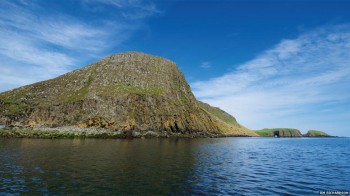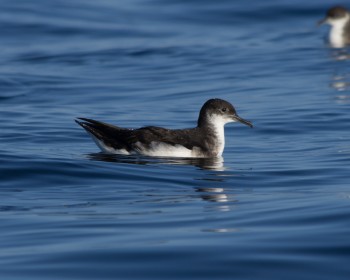The Shiant Isles are a group of privately-owned islands in the Outer Hebrides of Scotland. The three main islands in the group total c. 220 ha. The Shiants support large seabird populations, including Northern or Arctic Fulmars Fulmarus glacialis and Atlantic Puffins Fratercula arctica (65 200 pairs representing 10% of the UK’s population). Also present on the isles since about 1900 are Black or Ship Rats Rattus rattus which have been shown to include Shiant seabirds in their diet, obtained either (or both) by predation or scavenging.

Shiant Isles
The Shiants Seabird Recovery Project now aims to eradicate the islands’ rats, inter alia in the hope of allowing Manx Shearwaters Puffinus puffinus and European Storm Petrels Hydrobates pelagicus to commence breeding, for which there is some evidence of previous occurrence for at least the former species.

Manx Shearwater, photograph by Nathan Fletcher
“Plans to tackle the menace have been given a boost after £450,000 of European Union funding [under the LIFE+ programme, the European Union's environment fund] was awarded … to the Shiant Seabird Recovery Project. Scottish Natural Heritage is providing £200 000 and the remainder will be raised from donations. The project will use recordings of calls to attract the birds and will carry out active management to make sure the birds have the best opportunity to settle and breed” (click here).
“Following substantial research and consultation with specialists, an operational plan is being developed to eradicate the rats in the safest and most effective way, with the lowest risk of impacting native species, by laying poison in bait stations around the island” (click here).
The project to remove the rats is a partnership between RSPB Scotland, Scottish Natural Heritage
and the Nicolson family, owners and custodians of the Shiants.
“In April 2012 a survey of the Shiants estimated there to be around 3,600 rats on the islands. This number increases significantly in the summer months when more food is available. A study in 1998 found that 68% of the rats captured there had consumed feathers and quills. The presence of Manx shearwaters on the islands historically is supported both by the abundance of suitable nesting habitat, and the discovery by archaeologists of Manx shearwater bones in a 17th- and 18th-century midden heap on one of the islands. Evidence gathered from around the world demonstrates that the absence of shearwaters and storm petrels on the Shiants can be attributed to the presence of rats. The eradication approach in the Shiants has proven successful on a number of UK islands, including Canna, Ramsey and Lundy. Since the eradication of rats on Lundy, in the Bristol Channel, Manx shearwater numbers on the island have increased tenfold… ” (click here).
Click here to read about improving breeding habitat for Manx Shearwaters and European Storm Petrels by the successful removal of rats from the United Kingdom’s Scilly Isles.
With thanks to Chris Pollard for information.
Selected Literature:
Nicolson, A. 2001. Sea Room an Island Life. London: HarperCollins Publishers. 391 pp.
John Cooper, ACAP Information Officer, 13 June 2014, updated 22 June 2014

 English
English  Français
Français  Español
Español